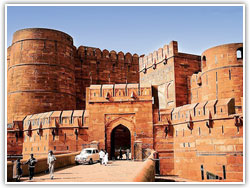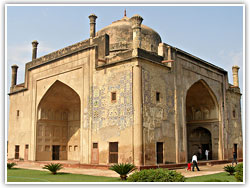|
|
Agra Attractions
.............................................................................................................................................................................. |
|
Tourist
Attractions in Agra
The main tourist attraction in Agra is Taj Mahal. Some
of the other famous monuments in Agra that epitomize the
high point of Mughal architecture are the Mughal Garden,
Agra Fort, Jami Masjid, Chini-Ka-Rauza and
Itmad-Ud-Daulah's Tomb. |
| |
|
Agra Fort
On the western banks of the Yamuna River, Agra
fort dominates the centre of the Agra. The site
was originally used by the son of Sher Shah, but
the present structure owes its origins to Akbar
who erected the walls and gates and the first
buildings inside. Shah Jahan built the impressive
imperial quarters and mosque, while Aurangzeb
added the outer ramparts. Akbar, the grandson of Babar built his capital at Agra and laid the
foundation of the Agra Fort. He began construction
of this |
 |
|
|
majestic fort in 1565 when he was only 23 years old.
This imposing red sandstone structure is the finest
example of craftsmanship of the Mughal era. After Taj
this was one of the most important group of buildings.
Agra fort is built in a triangular form and covers an
overall area of about 1.5 miles. The outer walls, just
over 20 metres high, faced with red sandstone and topped
with pointed merlons, tower above the outer moat. The
shape of the fort is that of a crescent, flattened on
the east to give a long nearly straight wall facing the
river, with a total perimeter of 2.4 km. This is
punctuated at regular intervals by bastions.
More....
Itmad-Ud-Daulah Tomb
Itmad-ud-Daulah Tomb is the least visited of Agra’s
three great monuments. Itmad-Ud-Daulah tomb was built by
Nur Jahan for his father Ghias-ud-Din Beg. He was a
Persian who had obtained service in Akbar's court. On
Jahangir's succession in 1605 he became Wazir or the
Chief Minister and received the title of ltmad-ud-daulah,
the pillar of the government. Itmad-ud-Daulah tomb was
built between 1622 and 1628 AD on the banks of the
Yamuna river. Nur Jahan built the tomb for the her
father in the pleasure garden that he himself had laid
out. It was constructed in the six years after her
father died in 1622. It was the first Mughal building to
be faced with white inlaid marble (inlaid with
contrasting stones). It is set in the traditional
garden. The tomb is not as big as the Taj Mahal but the
inlay designs and carvings are not less than Taj Mahal
and intimate. The Main chamber contains the tomb of
Itimad-ud-Daulah and his wife.
More.... |
|
|
|
Chini Ka Rauza
1 km to the north of the Itmad-ud-Daulah is the
Chini ka Rauza. Literally translated as the ‘China
Tomb’, this is the tomb of Afzal Khan who was in
the service of both Jahangir and Shah Jahan. He
died in Lahore in 1639 and was buried in Agra at
this tomb which he had constructed during his
lifetime. The chamber has been severely damaged
and the outside is decorated with enameled
plaster. The Persian influence is quite strong.
Ram Bagh. |
 |
|
|
Ram
Bagh is situated about 3 kms from Itmad-ud-Daulah.
Further upstream is what is believed to be the first
Mughal Garden in India Its name is a corruption of the
original “Arambag” which literally means garden of rest.
It was laid out by Babur as a pleasure garden and was a
resting place of his body before its interment at Kabul.
It is now in ruins, very little can be seen. There is
the Battis Khamba, a tall octagonal red sandstone cupola
supported on 36 pillars. Between the Chini ka Rauza and
Rambagh is Zuhara bagh, another enclosed garden named
after Zuhara, one of Babur’s daughters.
Taj Mahal
The crowning glory of the Agra is the Taj Mahal, a
monument of love and imagination, that represents India
to the world. It is the most famous monument in Agra and
one of the Seven Wonders of the World. This extravagant
monument of love is one of the most visited and most
photographed places in the world. Taj Mahal was built by
Shah Jahan in the memory of his beautiful wife Mumtaz
Mahal. Regardless of whether you see it ethereally
floating in the moonlight, blushing in the rosy glow of
dawn or reflected in the pools of its gardens, it is
enchanting. Perhaps the most moving view of the Taj
Mahal is from a little octagonal tower in the Agra fort
across the River Yamuna. It was here the Emperor Shah
Jahan spent his last days in imprisonment, gazing at the
tomb of his wife.
More....
Sikandra
Sikandra is about 10 kms from Agra. This city is named
after the great Afghan king, Sikandar Lodhi. This city
is visited by many tourists from all over the world.
Sikandra houses the world's famous Akbar's tomb. This
tomb is the most unique sculptured tomb of Asia, built
in the Indo-Saracenic style. This beautiful monument was
constructed by the Akbar himself. But later upon his
death it was completed by his son Jahangir in 1613.
Jahangir made many modification in the original plan of
the building. This tomb is divided into four square
parts. This structure has a perfect blend of Hindu,
Christian, Islamic, Buddhist and Jain motifs. The
blending is much like Deen-e-Ilahi, a new religion
started by Akbar. Some of its design features are
similar to the design of the Taj Mahal built later in
Agra.
More.... |
|
|
|